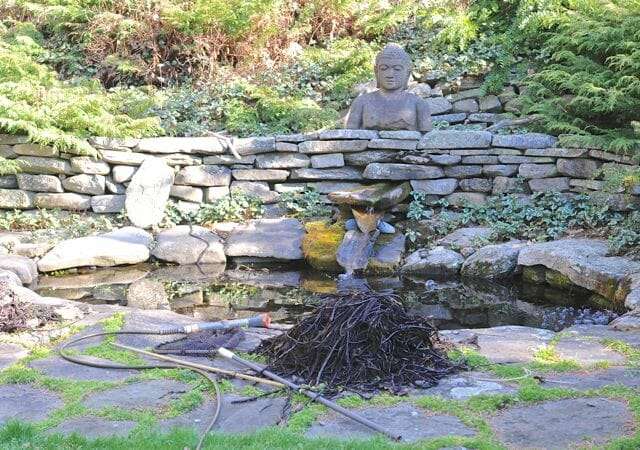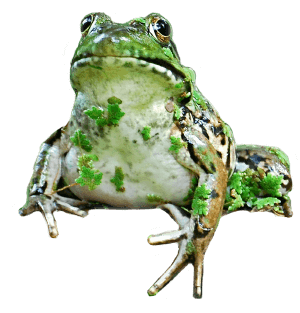14 springtime water-garden care tips

It’s not that hard, despite the sometimes-tenacious, gooey green stuff. And most important: There is no other feature of the garden that brings more joy—or sustains more wildlife, from birds to dragonflies, salamanders to frogs–than a pool or pond. My essential spring water-garden care tips:
1. Reduce debris (organic matter such as leaves on the bottom of the pool), which adds nutrients to the water as it decays and can thereby “feed” algae growth. I always do this just as soon as the ice on the pool allows—typically in March—using a net, then turn the plumbing back on. (Details on filtration below.)
I leave a layer at the bottom for amphibians to tuck into, but not as much as a fall and winter of leaves blown in by the wind has deposited.
I make another pass with the net and my hands in April, once the perennial water plants start to sprout so I can see which parts are alive and dead, removing the latter, but being careful not to disturb masses of frog and salamander eggs. That’s a pile of dead plants and leaves at poolside scooped out last weekend, in the top photo, and a spotted salamander below in my gloved hand. I discard the smelly, mucky debris around shrubs; they seem to enjoy the treat.
2. Excess nutrients can also enter ponds in the form of fertilizer runoff. Are you feeding flowerpots beside a water garden, or is the lawn adjacent (and being fertilized)? Not good!
3. Maybe think like the English, and add barley straw to your pond—whether actual straw stuffed into a floating sachet-like net bag, or one of the newer extract products (pellets, powders–both seen below–and even liquids). Barley straw helps make the water inhospitable for algae. The bagged straw sachets last about six months, the other products a shorter time.
4. Non-toxic additives can help, some water gardeners believe. I have been experimenting with other non-toxic and/or biological additives (liquids or powders, sometimes formulated in combination with barley extract as mentioned; photo below). Depending on the formula, they may help settle particles out of the water onto the bottom, and/or add enzymes and “helpful” bacteria, and I am favorably impressed, I think. According to label directions, these are added periodically through the season.
5. Changing the water, by the way, doesn’t work, and can actually backfire. Work to improve what you have, consistently keeping a vigilant eye out and adjusting things throughout the season.
6. Aerating the water (with a small spillway or waterfall, for instance) can help fight some species of algae, but not all, but is preferable to stagnant water for various other reasons. And who doesn’t love the sound of moving water?
7. Filter, the biological way. I have pumps and biological filters for both my pools (one in the water in my smaller pool; one external unit for the larger, like this). Inside biological filters, a community of helpful organisms including bacteria builds up on the filter “medium,” which is often made of foam or what looks like packing peanuts. The organisms help digest the unwanted pond wastes. Highly recommended. My units have each lasted many years, though every so often foam inserts may need to be replaced.
8. UV “clarifiers” can help, too. Some pond filters incorporate the use of ultraviolet lightbulbs. When the water passes by these “clarifiers,” or “sterilizers,” as they are called, algae buildup is prevented. Independent clarifying devices—not housed within the filter box—are also available at pond-supply vendors.
9. Critical: Shade the water (at least one-third of the surface should be shaded, some experts say; I shade most of the surface of my sunnier pond). Ponds in full sun will be most challenging to manage, and algae will romp. Shading can be accomplished by (surprise!) siting your pond in part shade, or planting shrubbery or grasses or other shade-casting things nearby. Most important and easier:
10. Floating water plants will shade the pond surface (and some also help with overall water health besides blocking light that would encourage algae). They are essential; I order by mail from Waterford Gardens or Pond Plants Online but there are many such sources. I love tiny Azolla, for instance, called fairy moss, and slightly larger Salvinia and even tiniest duckweed (Lemna). You might prefer big, bold water lilies, or towering pots of large-leaved elephant ears. Note: Never put water-garden plants into natural waterways, lakes, ponds, etc.
11. One more shading tactic: non-toxic black water dye (sold as a powder or liquid; the powder seems far more concentrated), which I also like because it helps hide the submersed plumbing in my small pools. I’d use it for that reason alone, though various labels also claim it reduces light in the water. The dye lasts a few weeks or a month, then needs to be reapplied.
12. If floating foamy-looking or stringy algae does occur, reduce it promptly. You can use a net, but I do it with my hand, moving in a swirling motion to gather it into clumps. Squeamish? Use a bamboo cane in the same motion.
13. Net the surface in fall, or not? Various experts advise placing a net over the pond in fall to prevent debris from re-entering the pool, but my frogs, birds and other pond visitors and residents would strongly object (and even potentially be injured trying to navigate such netting). I say no, and just use a net to remove debris as above.
14. Speaking of the other end of the season: Follow my fall pond-care steps, which do not include water changes and scrubbing the liner. They do include keeping a hole open in the ice that might form on the surface, to prevent buildup of suffocating gasses under the surface (and also welcome wildlife who want to drink or bathe 365 days a year).







I love amphibians and frogs especially. Would like to install a small water pond and have the perfect spot for it. Do you have a link to the materials you used for your pretty ponds and possibly step-by-step instructions? Such as depth, type of liner and so forth. I want it to look as natural as possible.
Did you literally dig it with shovel?
Love your podcasts and learn so much every single episode.
I also would like to hear more about installing a pond. I live in Lebanon, NH, zone 4.
Just heard the news that LilyPons, in Burkettsville, Maryland, is closing. End of an era.
I’ve had my shaded water garden in northern MN for 25 years. The first fall I didn’t drain it and in the spring had lots of dead frogs that had tried to estivate but froze instead. Now I siphon it out with a hose each fall and give the frogs a chance to leave and go to the swamp across the highway or to the lake (I guess). They always return each spring and I enjoy the sound of the spring peepers plus seeing the leopard frogs. And no more dead frogs.
Neighborhood raccoons do damage to my little pond (they even topple the bird water stands) by pulling plants out and moving rocks. The raccoons are fun to watch but the damage is discouraging. They also destroy netting. You must have raccoons, too?
I have a 1 acre pond with lots of waterfowl “visitors”. I want to plant native lotus and many sources recommend they be put in closed pots due to their aggressive growth. I have trouble keeping my cattails due to geese predation, so wasn’t sure if it would be ok to plant lotus directly in the pond as the geese might keep them in check. Any experience or heard anything on this from others? Thanks in advance for any help you can give me.
I needed this! I’ve been battling string algae for past 2 years and apparently I’ve done everything wrong, having read and listened to not-so-great info! Thanks!!
Big… big help. Developing a frog pond.